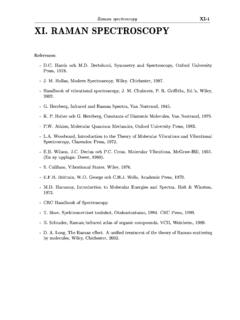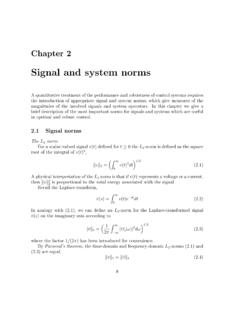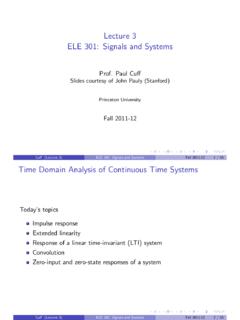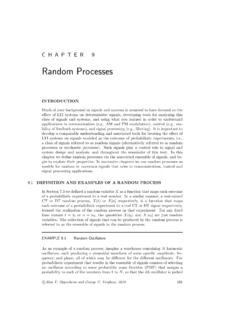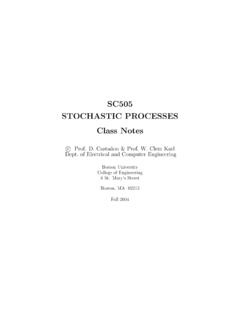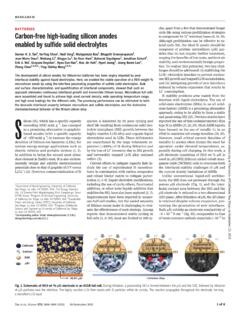Transcription of SINUSOIDAL SIGNALS - Åbo Akademi
1 SINUSOIDAL SIGNALS . SINUSOIDAL SIGNALS . x(t) = cos(2 f t + ). = cos( t + ) (continuous time). x[n] = cos(2 f n + ). = cos( n + ) (discrete time). f : frequency (s 1 (Hz)). : angular frequency (radians/s). : phase (radians). 2. SINUSOIDAL SIGNALS A cos( t). A. A sin( t). 0. A. 0 T/2 T 3T/2 2T. xc(t) = A cos(2 f t) xs(t) = A sin(2 f t). = A cos(2 f t /2). - amplitude A -amplitude A. - period T = 1/f -period T = 1/f - phase: 0 -phase: /2. 3. WHY SINUSOIDAL SIGNALS ? Physical reasons: - harmonic oscillators generate sinusoids, , vibrating structures - waves consist of sinusoidals, , acoustic waves or electromagnetic waves used in wireless transmission Psychophysical reason: - speech consists of superposition of sinusoids - human ear detects frequencies - human eye senses light of various frequencies Mathematical (and physical) reason: - Linear systems, both physical systems and man-made filters, affect a signal frequency by frequency (hence low- pass, high-pass etc filters).
2 4. EXAMPLE: TRANSMISSION OF A LOW-FREQUENCY signal USING. HIGH-FREQUENCY ELECTROMAGNETIC (RADIO) signal . - A POSSIBLE (CONVENTIONAL) METHOD: AMPLITUDE MODULATION (AM). Example: low-frequency signal v(t) = 5 + 2 cos(2 f t), f = 20 Hz High-frequency carrier wave vc(t) = cos(2 fct), fc = 200 Hz Amplitude modulation (AM) of carrier (electromagnetic) wave: x(t) = v(t) cos(2 fct). 5. 8. 6. 4. 2. v 0. 2. 4. 6. 8. 8. 6. 4. 2. x 0. 2. 4. 6. 8. 0 t Top: v(t) (dashed) and vc(t) = cos(2 fct). Bottom: transmitted signal x(t) = v(t) cos(2 fct). 6. Frequency contents of transmitted signal x(t) = v(t) cos(2 fct). = (5 + 2 cos(2 f t)) cos(2 fct). = 5 cos(2 fct) + 2 cos(2 f t) cos(2 fct). Trigonometric identity: 1 1. cos cos = cos( ) + cos( + ).
3 2 2.. 2 cos(2 f t) cos(2 fct) = cos (2 (fc f )t)+cos (2 (fc + f )t). 7.. x(t) = 5 cos(2 fct) + cos (2 (fc f )t) + cos (2 (fc + f )t). 5 Spectrum Spectrum of v(t) of vc(t). 2. 1. - 0 20 200 Frequency Spectrum of x(t) 5. 1 1. - 0 180 200 220. Frequency 8. We see that a low-frequency signal in frequency range 0 fs fmax (baseband signal ). can be transmitted as a signal in the frequency range fc fmax f fc fmax ( RF (radio frequency) signal ). Another analog modulation technique is frequency modulation (FM). 9. Representation of SINUSOIDAL signal A. Amplitude and phase B. Sine and cosine components C. Complex exponentials 10. A. Amplitude and phase x(t) = A cos(2 f t + ). or x(t) = A cos( t + ). where = 2 f is the angular frequency (radians/second).
4 The phase describes translation in time compared to cos( t): x(t) = A cos( t + ) = A cos( (t + / )). 11. B. Sine and cosine components x(t) = a cos( t) + b sin( t). Follows from trigonometric identity: cos( + ) = cos( ) cos( ) sin( ) sin( ).. x(t) = A cos( t + ). = A cos( ) cos( t) A sin( ) sin( t). Hence: a = A cos( ), b = A sin( ). and, conversely, . A = a2 + b2, = arctan(b/a). 12. EXAMPLE. x(t). 1. 0. 1. 2 0 2 4 6 8 10 12. signal x(t) = cos( t + ). Period: T = 10 (s). Frequency: f = 1/T = (s 1 =Hz (periods/second)). Angular frequency: = 2 f = (radians/s). 13. A. Representation using amplitude and phase Amplitude: A = 1. From figure we see that x(t) = cos( (t 2)). But x(t) = cos( t + ) = cos( (t + / ).. Phase: = 2 = radians or 180/ = 72.)
5 14. B. Sine and cosine components x(t) = a cos( t) + b sin( t) where a = cos( ) = cos( ) = b = sin( ) = sin( ) = 1 x(t). 0. 1. 2 0 2 4 6 8 10 12. 1 Cosine component Sine component 0. 1. 2 0 2 4 6 8 10 12. x(t) = cos( t) + sin( t). 15. C. Representation using complex exponentials Background. A common operation is to combine SINUSOIDAL components with different phases: x(t) = A1 cos( t + 1) + A2 cos( t + 2). One way: first write A1 cos( t + 1) = a1 cos( t) + b1 sin( t). A2 cos( t + 2) = a2 cos( t) + b2 sin( t). Then x(t) = (a1 + a2) cos( t) + (b1 + b2) sin( t). 16. Streamlining the above procedure We have: cos( t + ) = cos( ) cos( t) sin( ) sin( t). and sin( t + ) = sin( ) cos( t) + cos( ) sin( t). Instead of working with the two SIGNALS cos( t) and sin( t) it is convenient to working with the single complex-valued signal g( t) = cos( t) + j sin( t).
6 Where j = 1 (imaginary unit number). 17. Im 6. g( t) = cos( t) + j sin( t). j sin( t) *.. 1 .. t - cos( t) Re Then: g( t + ) = cos( t + ) + j sin( t + ). = cos( ) cos( t) sin( ) sin( t).. +j sin( ) cos( t) + cos( ) sin( t).. = cos( ) + j sin( ) cos( t) + j sin( t). = g( )g( t). 18. In terms of the complex-valued signal , phase shift with angle . is equivalent to multiplication by the complex number g( ): g( t + ) = g( )g( t) (A).. cos( t + ) = Re (g( )g( t)). sin( t + ) = Im (g( )g( t)). We will see that using the multiplication (A) to describe phase shifts results in significant simplification of formulae and calculations 19. Properties of the complex function g( ) = cos( ) + j sin( ): - g(0) = 1. - g( 1 + 2) = g( 1)g( 2).
7 Dg( ). - d = sin( ) + j cos( ) = jg( ). The only function which satisfies these relations is g( ) = ej . e = .. (Euler's number). 20. Hence we have: Euler's relation ej = cos( ) + j sin( ). e = .. (Euler's number). As e j = cos( ) j sin( ) we have 1 j j .. cos( ) = e +e 2. 1 j j .. sin( ) = e e 2j 21. It follows that x(t) = a cos( t) + b sin( t).. a b j t a b = + e + e j t 2 2j 2 2j 1 1. = (a jb) e + (a + jb) e j t j t 2 2. or x(t) = c ej t + c e j t where c = 12 (a jb) and c = 12 (a + jb) (complex conjugate). Thus the cosine and sine components are parameterized as the real and imaginary components of the complex number c 22. PREVIOUS EXAMPLE: The signal x(t) = cos( t ). = a cos( t) + b sin( t). = cos( t) + sin( t).
8 Can be represented using complex exponentials as x(t) = c ej t + c e j t where 1. c = (a jb) = 2. 1. c = (a + jb) = + 2. Hence: x(t) = ( ) ej t + ( + ) e j t 23. SUMMARY. Let us summarize the results so far. We have the following alternative representations of a SINUSOIDAL signal : Amplitude and phase: x(t) = A cos( t + ). Sine and cosine components: x(t) = a cos( t) + b sin( t). where a = A cos( ), b = A sin( ). or p A= a2 + b2, = arctan(b/a). 24. Complex exponentials: x(t) = c ej t + c e j t where 1 1. c = (a jb) , c = (a + jb). 2 2. or a = 2Re(c), b = 2Im(c). 25. EXAMPLE - signal transmission with reflected component Transmitted signal : x(t) = cos( t). Received signal : y(t) = x(t) + rx(t ). PROBLEM: Determine amplitude and phase of y(t).
9 We have y(t) = cos( t) + r cos( (t )). The problem can be solved in a straightforward way by introducing complex exponential: 1 j t j t . x(t) = e +e 2. 26. Then: y(t) = cos( t) + r cos( (t )). 1 j t 1 . = e + e j t + r ej (t ) + e j (t ). 2 2. 1 j . j t 1 j . j t = 1 + re e + 1 + re e 2 2. Here, 1 1 . 1 + re j = 1 + r cos( ) jr sin( ). 2 2. and 1 1 . 1 + rej = 1 + r cos( ) + jr sin( ). 2 2. 27. Then, defining a = 1 + r cos( ), b = r sin( ). we have (cf. above). 1 1. y(t) = (a jb) e + (a + jb) e j t j t 2 2. = a cos( t) + b sin( t). = Ay cos( t + y ). where p Ay = a2 + b2, y = arctan(b/a). 28. SOME SIMPLIFICATIONS. As 1 1. a cos( t) + b sin( t) = (a jb) e + (a + jb) e j t j t 2 2. it follows that it is sufficient to consider the complex-valued signal 1.
10 (a jb) ej t 2. Here, the complex number 1. c = (a jb). 2. determines the signal 's amplitude and phase. 29. To see how this works, consider a linear dynamical system with input x(t) and output y(t). x(t) - G - y(t). For the SINUSOIDAL input x(t) = cos( t). the output takes the form y(t) = A cos( t + ) = a cos( t) + b sin( t). and we want to determine the amplitude A and phase . 30. As the phase shift introduces a combination of cosines and sines, the problem can be simplified by embedding the input signal into a larger class of SIGNALS involving both a cosine and a sine component. It turns out that a convenient way to do this is to consider the complex input signal xc(t) = cos( t) + j sin( t). = ej t The output then also has real and imaginary components: yc(t) = A cos( t + ) + jA sin( t + ).
